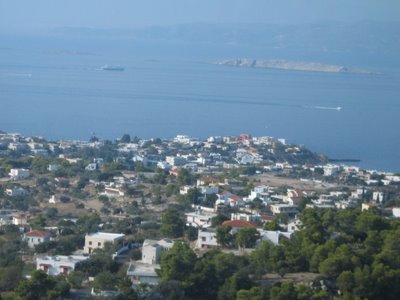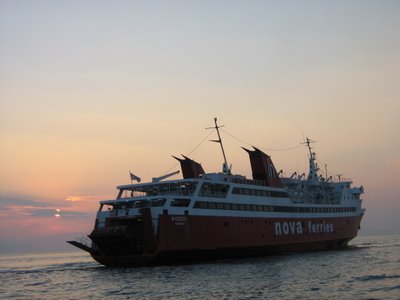Some Facts and historical mythology about Aegina Island ( from wikipedia
) This is a list of some of the 1400
islands of
Greece, of which 227 are inhabited. Only 78 islands have more than 100 inhabitants.
Aegina (
Greek: Αίγινα (Egina)) is one of the
Saronic Islands of
Greece in the
Saronic Gulf, 31 miles (50 km) from
Athens.
Tradition derives the name from Aegina, the mother of
Aeacus, who was born in and ruled the island. In shape Aegina is triangular, eight miles (13 km) long from northwest to southeast, and six miles (15 km) broad, with an area of about 41 square miles (106 km²). Two thirds of Aegina constitutes an extinct volcano. Population 15,000.
Temple of Aphaea, dedicated to its namesake, a goddess which was later associated with
Athena; the temple was part of a pre-Christian, equilateral holy triangle of temples including the Athenian
Parthenon and the temple of
Poseidon at
Sounion. The Monastery of Agios Nectarios, dedicated to Saint
Nectarios, the last saint of the Greek Orthodox Church, is another attraction on Aegina.
After the liberation from Turkish Rule (freedom battle on 1821) in
1826-
1828 the town became for two years (Jan. 1828 - Dec. 1829) the first capital of Modern Greece. Today Aegina is a famous tourist destination.
In
Greek mythology,
Aegina was a daughter of the river god
Asopus and the
nymph Metope. She bore at least two children:
Menoetius by
Actor, and
Aeacus by
Zeus.
When Zeus abducted Aegina, he took her to
Oenone, an island close to
Attica. This island would later be called Aegina. Here, Aegina gave birth to Aeacus, who would later become king of Oenone; henceforth, Aegina.
Agios Nectarios : This is the biggest church in greece - dedicated to Saint
Nectarios, the last saint of the Greek Orthodox Church
the HARBOUR – personal boat area

the PANORAMIC view of the island from the top of the mountain - we took a conducted tour

the historic streets in aegina
the traditional greek RESTAURANT – small TIFFIN with sea food – octopus, SQUID, prawn, salad and ursa

the city of aegina – nice view from port

Coming back to Athens after having a memorable and enchanting journey in the small island in the Mediterranean Sea




 The picturesque town of Poros with its beautiful neoclassical buildings is built amphitheatrically on the slopes of a hill. Its most famous landmark is a clock tower, built in 1927.
The picturesque town of Poros with its beautiful neoclassical buildings is built amphitheatrically on the slopes of a hill. Its most famous landmark is a clock tower, built in 1927.


 Monastiri is located tothe east side of the island. It is a quiet, organised beachwith clear waters and picturesque tavernas.It is under the hill that lies Monastiri, next to pine treesand luxurious hotels.
Monastiri is located tothe east side of the island. It is a quiet, organised beachwith clear waters and picturesque tavernas.It is under the hill that lies Monastiri, next to pine treesand luxurious hotels.














